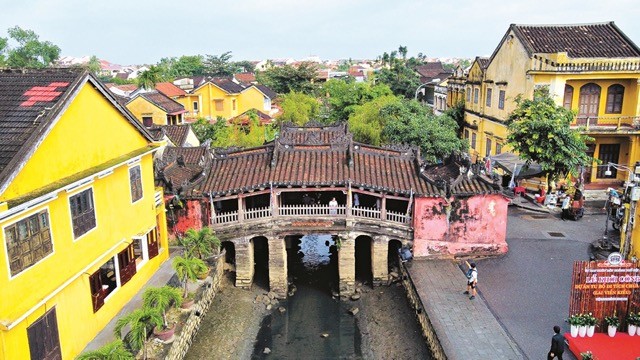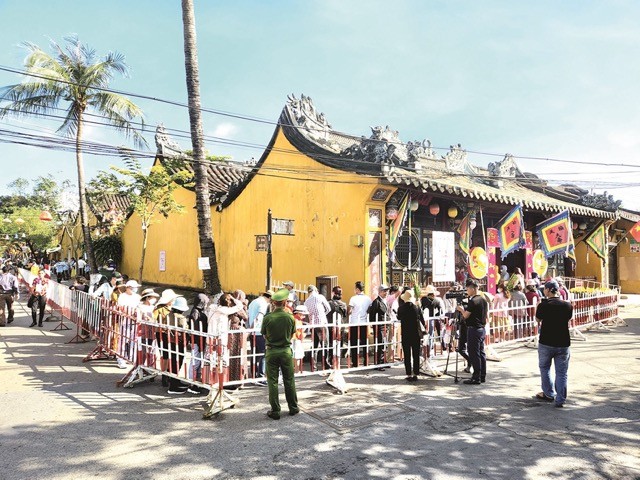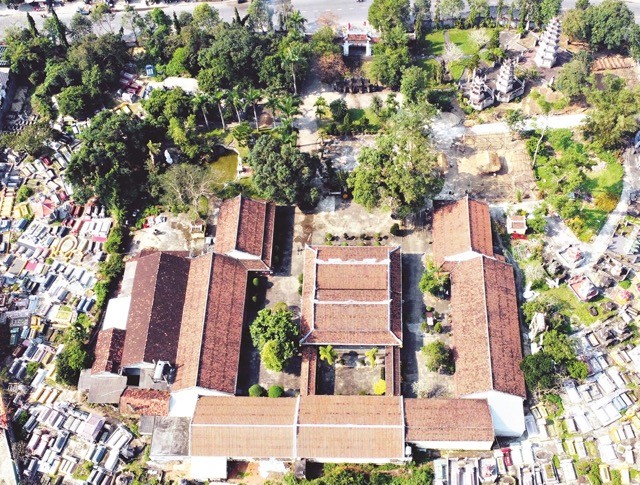Hoi An – The Land of Heritage Pagodas
1. Cau Pagoda (Chua Cau)
The first one on the list of Hoi An’s heritage pagodas is Cau Pagoda (Chua Cau). It was created for commuting. There are two parts of this relic site, “the bridge” and “the pagoda”. They are built more than half a century apart but blended seamlessly with each other to create a symbolic landmark of Hoi An.
 |
| According to researchers, the architecture alone with the two subjects “Pagoda” and “Bridge” linked together into a unified whole is unique in the architectural treasure of Viet Nam (Photo:HS) |
The temple worships a local god named Bac De Tran Vu, a spiritual figure of peace and stability in the terrain and weather of Hoi An. According to the epitaph at Cau Pagoda and other sources, this relic was built in the late 16th – early 17th centuries, restored and repaired 7 times. The latest repair took place in 1986.
Cau Pagoda also worships a pair of dogs and a pair of monkeys, representing Japanese symbols of worship landmarks. On the door of the Cau Pagoda, there is a wooden diaphragm made in 1719, embossed with 3 words “Lai Vien Kieu”, on the left is the seal of Lord Nguyen Phuc Chu.
According to Quang Nam newspaper, Vice Chairman of Hoi An City’s People’s Committee Nguyen Van Lanh said that this monument was proposed to build and invest capital by Japanese traders, but was designed, and constructed by Vietnamese people.
The Vietnamese design embodied by Cau Pagoda represents the cultural interference of both Chinese and Japanese. The Chinese designers, with their architectural thinking, are known for large-scale projects while the Japanese is known for tall structures. Instead, the Cau Pagoda has a capable size, expressing the human outlook and worldview of the local residents.
Cau Pagoda stood out among Vietnam’s tiled bridges because of its unique, harmonious Hoian-styled ecological resources and cultural heritage. Located in the heart of the old town, Cau Pagoda is a testament to the no duplicate beauty of the heritage city.
2. Ong Pagoda (Chua Ong)
 |
| A line of people offering and praying for peace at Ong Pagoda during the Lunar New Year (Photo: HS) |
Ong Pagoda (Quan Cong Temple) is located on Tran Phu Street. This street is known for its large Chinese descent community, hence the temple being a destination for the community and tourists on Chinese calendar holidays.
This site was built for the first time in 1653. It used to be considered a holy center in Hoi An. Ong Pagoda is one of the nine ancient relics in Hoi An Ancient Town that are valuable in many aspects, especially in architectural structure. Although carrying out Chinese architecture, the relic is still a remarkable structure, especially when being done by Kim Bong artisans.
Ong Pagoda has been well-preserved after several restorations, the latest being in 1966. The structure and decorations show typical temples and old pagodas in Hoi An. The temple’s structure symbolizes the Han character “Quoc” (which means country), created by many buildings standing near each other.
It also contains much beneficial information related to ethnography, sociology and more. The parallel sentences include content about the philosophy of life which has cultural values. Those sentences not only help to shape people’s lifestyles in the old society but are also compatible with building new ways of life and new people today.
3. Chuc Thanh Pagoda
The last one on the list is Chuc Thanh Pagoda. Also appearing in the flourishing period of the commercial port of Hoi An, Chuc Thanh Pagoda is one of the most ancient pagodas in the ancient town. According to Hoi An Center for Cultural Heritage Management and Preservation, Monk Luong The An is the founder of Chuc Thanh Pagoda.
The name Chuc Thanh means wishing God the best, which shows people’s gratitude towards Nguyen lords in embracing Buddhism and monks.
Chuc Thanh Pagoda (Ton Duc Thang street) was built in the late 17th century. It started as a simple cottage, but generations of monks have expanded it into a colossus as it is known today.
At dusk, the harmony between the pagoda’s foreign and domestic, traditional and modern architecture is highlighted. On the campus, there are many tomb towers of zen masters, but the most dominant one is the stupa of patriarch Minh Hai.
According to the locals, about three decades ago, despite being relatively close to the Hoi An Old Quarter, Chuc Thanh pagoda was located in a rural area. Around the pagoda, there is a scattering of willow trees and the entrance is full of sand.
 |
| Vice Chairman of Hoi An People’s Committee – Nguyen Van Lanh said Hoi An is the birthplace of the Lam Te – Chuc Thanh school, one of the biggest Buddhism schools in Vietnam (Photo:HS) |
The post Hoi An – The Land of Heritage Pagodas appeared first on Vietexplorer.com.
View more from VietExplorer:
Famous artists slated to promote tourism under proposalNo vaccine tours to the US this year: tourism department
Florist raises 2 duckling staff
Greenery in Truong Sa island district
Vietnam’s iconic One Pillar Pagoda reconstructed using virtual reality technology
Vietnamese film ‘Old Father’ hits U.S. cinemas
Unique undersea path at Nhat Tu Son Island
Vietnam’s unique symphony orchestra, with video
Famous Vietnamese paintings to be auctioned at Christie’s
In photo: Shopping in Covid-19 – Put money in bucket, goods in pot
Brownish yellow hollong flowers carpet Saigon sidewalk
Y Ty rice terraces in pouring-water season
Vietnam’s cashew industry suffering
COVID-19-hit workers should benefit from 2.6 billion USD aid package
FDI disbursement up 6.7 percent
Photo Hanoi ’21 month to connect public with photographic art
Ngo Tu Ha – the first printer of banknotes with Uncle Ho’s image
Belgian woman in Vietnam: Pick up lost sandal on roads
The ancient songs of Tuyen Quang
Heritage trees on Truong Sa archipelago
Comments
Post a Comment